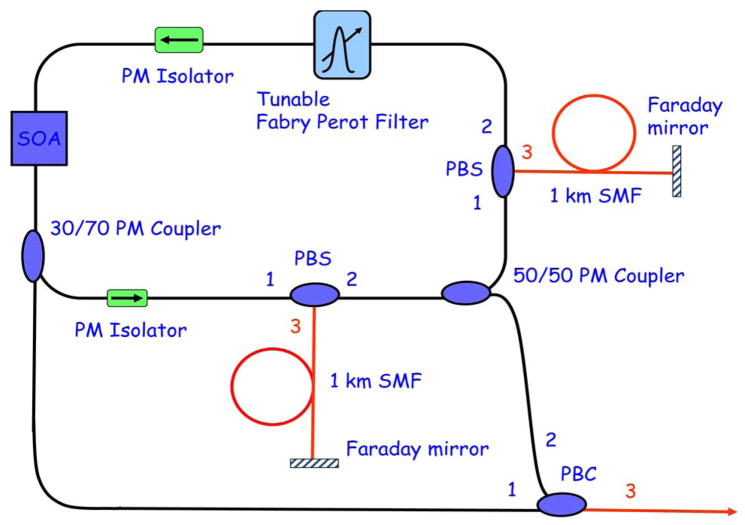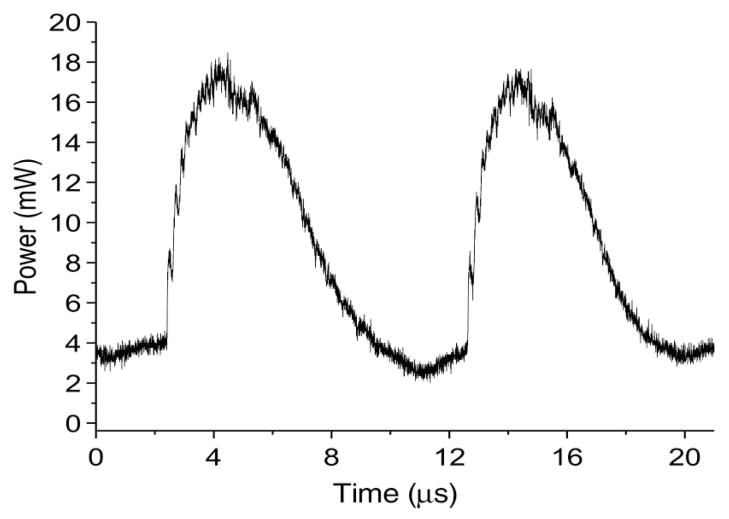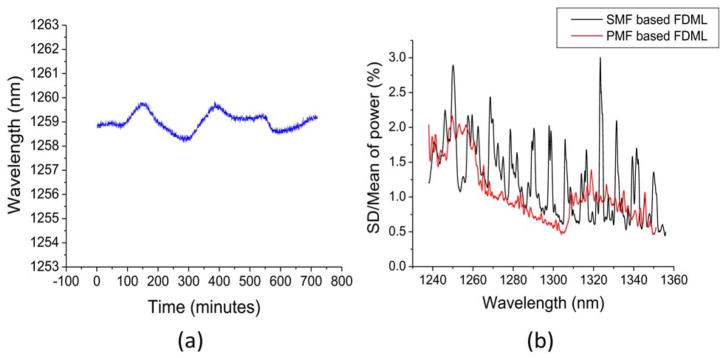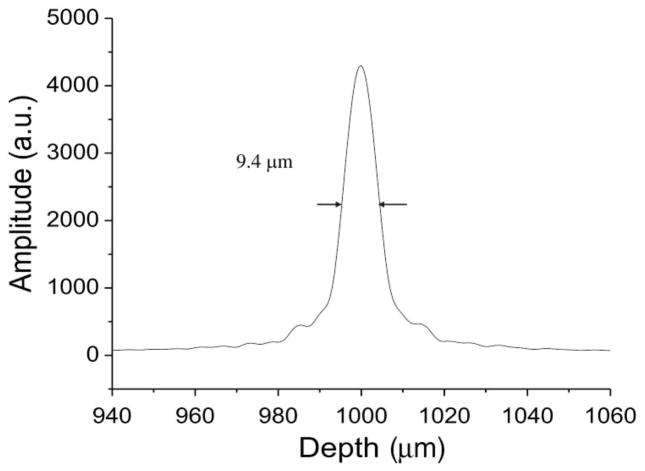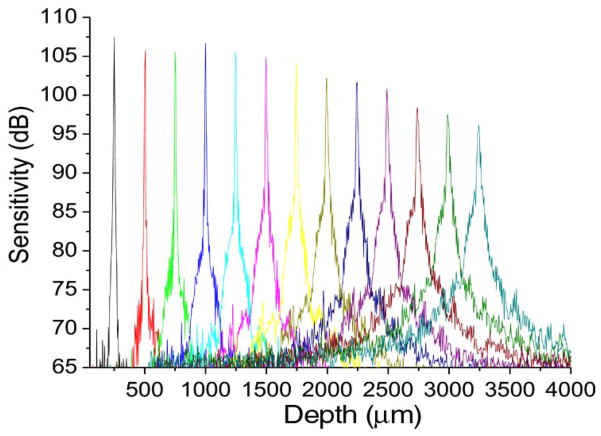Abstract
A polarization-maintaining buffered Fourier domain mode-locked (FDML) swept source with a center wavelength of 1300 nm is demonstrated. The scanning rate of the buffered FDML swept source is doubled without sacrificing the output power of the swept source by combining two orthogonally polarized outputs with a polarization beam combiner. The stability of the swept source is improved because the polarization state of the laser beam inside the laser cavity is maintained without the use of any polarization controllers. The swept source is capable of an edge-to-edge tuning range of more than 150 nm and a FWHM range of 95 nm at a 102 kHz sweeping rate and with an average power of 12 mW. A swept source optical coherence tomography (SSOCT) system is developed utilizing this buffered FDML swept source. The axial resolution of the SSOCT system is measured to be 9.4 μmin air. The sensitivity of the SSOCT system is 107.5 dB at a depth of 0.25 mm with a 6 dB roll-off at a depth of 2.25 mm.
Optical coherence tomography (OCT) is a noninvasive, noncontact imaging modality that uses coherent gating to obtain high-resolution, cross-sectional images of tissue microstructure [1]. The development of Fourier domain OCT, including swept source OCT (SSOCT) [2–4] and spectral domain OCT (SDOCT) [5–7], has significantly increased the imaging speed and sensitivity of OCT systems. Compared with a SDOCT system that uses a large array line scan camera, SSOCT proves to be a better choice at 1.3 μm due to its simpler system design since no spectrometer is required. Furthermore, narrower spectral line widths can be achieved without cross talk, which results in a larger imaging range.
To build a high-speed SSOCT system, a swept source with a fast scanning speed is required. Recently, the new swept sources utilizing the Fourier domain mode-locked (FDML) technique have attracted much attention because broad sweep ranges, narrow instantaneous line widths, unprecedented sweep rates, and high phase stability can be obtained by extending the laser cavity and periodically driving the optical bandpass filter synchronously with the optical round-trip time of the propagating light wave in the laser cavity [8–12]. For tailoring the output and for multiplying the sweeping rate of FDML lasers, buffered FDML was developed by combining two time-delayed copies of a sweep with a fiber coupler. Highly stable, unidirectional wavelength sweeps without sacrificing the sweeping rate can be achieved with this technique [10,11]. However, only half of the output power can be used because the output light is coupled from one output arm of a 50/50 fiber coupler. In addition, polarization of a conventional FDML laser is wavelength dependent due to the long single-mode fiber (SMF) used in the cavity. Therefore, one needs to carefully adjust polarization controllers to control the polarization states of light within the cavity to achieve the best performance for a given gain medium, usually a polarization-dependent semiconductor optical amplifier (SOA), to maintain optimum lasing and, hence, a stable output power and bandwidth. Polarization-maintaining (PM) fibers combined with fiber polarizers were used to build a nonbuffered FDML swept source without the use of polarization controllers [13]. However, the detailed characterization of the source was not given.
In this Letter, a PM-buffered FDML swept source is demonstrated. The scanning rate is doubled without sacrificing the output power of the swept source by combining two orthogonally polarized outputs with a polarization beam combiner (PBC). In addition, the stability and robustness of the swept source are significantly improved because the polarization state of the laser beam inside the cavity is maintained without the usage of any fiber polarization controllers. With the linear polarization states of the output laser beam, the buffered FDML swept source is also ready to be used in a PM-fiber-based polarization-sensitive OCT system [14].
Figure 1 shows the setup of the PM-buffered FDML swept source. The swept source is composed of a PM ring along with two single-mode (SM) delay lines. In the ring portion, a PM fiber pig-tailed SOA (Covega, Inc.) is used as the gain medium while a PM fiber Fabry–Perot tunable filter (FFP-TF, LambdaQuest, Inc.) provides the wavelength selection. Two associated PM isolators are used to force unidirectional propagation in the cavity. The delay lines are formed with two lengths of SM optical fibers, each 1 km long. Two Faraday mirrors are placed at the end of each SMF respectively to rotate the polarization by 90° and reflect the light back to the ring cavity. The light from the SOA is linearly polarized along the slow axis of the output PM fiber. 30% of the light is coupled out by a PM coupler and the remaining 70% of the light is transmitted through port 1 of a polarization beam splitter (PBS) to the first 1-km-long SM delay line fiber. The polarization state of the reflected light is orthogonal to that of the input light at port 3 of the PBS. Thus, the reflected light is coupled back to port 2 of the PBS and linearly polarized along the slow axis of the PM output fiber of the PBS. Subsequently, 50% of the light is tapped out by a 50/50 PM coupler. The remaining 50% of the light is transmitted through port 1 of the second PBS to the other 1-km-long SMF. The reflected light is coupled back to port 2 of the second PBS and transmitted through the PM fiber pig-tailed FFP-TF to the SOA.
Fig. 1.
(Color online) Schematic setup of the PM-buffered FDML swept source. SOA, semiconductor optical amplifier; PM, polarization-maintaining; PBS, polarization beam splitter; SMF, single-mode fiber; PBC, polarization beam combiner. Red lines denote SM parts and black lines denote PM parts.
The FFP-TF is driven at a frequency of 51 kHz, which is synchronous to the round-trip time of light in the cavity. A forward (short to long) and a backward (long to short) wavelength sweep are generated during each drive cycle. The SOA is modulated to suppress and replace the forward wavelength sweep with a delayed backward wavelength sweep because the forward wavelength sweep generates increased noise at high sweep rates [10].
The two orthogonally polarized outputs are combined with a PBC. The sweep rate is doubled to be 102 kHz with two sweeps during one drive cycle, while the output power of the swept source is not sacrificed. Figure 2 shows the temporal power profiles of the swept source. The average power of the output light is measured to be 12 mW.
Fig. 2.
Temporal power profiles of both sweeps during one drive cycle of the swept source.
The scanning range of a swept source is usually measured with an optical spectrum analyzer (OSA). However, the sweeping spectrum of a nonlinearly driven swept source measured with an OSA is not accurate because an OSA is based on energy instead of power detection. In this study, an interference signal with evenly distributed spectral combs generated by a Mach– Zehnder interferometer is adopted to measure the spectrum of the swept source. A fiber Bragg grating is used to synchronously generate a wavelength reference to map the interference fringes to wavelengths. The total scanning range of the swept source is determined to be 152 nm. The FWHM scanning range is measured to be 95 nm at a center wavelength of 1300 nm.
In a conventional FDML swept source, the polarization state of the laser beam is wavelength dependent due to the long SMF used in the laser cavity. One needs to carefully control polarization states of the light beam and adjust fiber polarization controllers in the cavity for optimum performance of the polarization-dependent SOA. This leads to decreases in the stability of the swept source and inhibits its expanded use in clinical situations. The PM-buffered approach in this design contains no fiber polarization controllers, resulting in improved stability. To evaluate the stability of the swept source, the wavelength fluctuation at a fixed temporal position and the spectral power at each wavelength of the swept source are monitored every 20 s over a 12 h period. The standard deviation of the wavelength fluctuation is calculated to be 0.36 nm, as shown in Fig. 3(a). This wavelength drift is due to environmental disturbances, such as temperature fluctuations. Figure 3(b) illustrates the ratios of the standard deviation to the mean of the spectral power of a conventional SMF-based FDML source [9] and a PM-buffered FDML source. The reduced ratio for the PM-buffered source indicates increased performance stability.
Fig. 3.
(Color online) (a) Wavelength fluctuations of the source monitored every 20 s over a 12 h period. (b) Spectral power fluctuations of a conventional SMF-based FDML source (black curve) and a PM-buffered FDML source (red curve) monitored every 20 s over a 12 h period.
The output light from the FDML laser is coupled into an SSOCT system. The fringe signals collected by photodetectors are digitized by a 250 million samples/s 12 bit analog-to-digital data acquisition converter (ATS 9350, AlazarTech Inc.) and transferred to a computer for processing. Parallel computing algorithms with a dualquad- core high-speed-processor-based workstation are used to achieve real-time processing and display [15].
Figure 4 shows the point spread function (PSF) measured with a partial reflector placed at a depth of 1 mm. The axial resolution of the SSOCT system is measured to be 9.4 μm in air, corresponding to an effective axial resolution of 6.7 μm in tissue (n = 1.4).
Fig. 4.
PSF of the FDML SSOCT system.
The sensitivity of the SSOCT system is measured with a −40.5 dB partial reflector as the sample. As shown in Fig. 5, the sensitivity is 107.5 dB at a depth of 0.25 mm and decreases by 6 dB at a depth of 2.25 mm. The corresponding instantaneous linewidth of the swept source is calculated to be 0.33 nm. The increasing width of the PSFs at larger depths results from residual errors in spectral calibration, which is for conversion from time to wavenumber space.
Fig. 5.
(Color online) PSF of the FDML SSOCT system showing a sensitivity of 107.5 dB at a depth of 0.25 mm and 101.5 dB at a depth of 2.25 mm.
To illustrate the performance of the system in biological tissues, a human finger is imaged, as shown in Fig. 6. Two-dimensional imaging of a 5 mm × 2 mm area is processed and displayed at a rate of 200 frames/s (512 A-lines per frame). The fixed pattern near a depth of 500 μm is due to spectral modulations generated by a cross talk between the fast and slow axes of the PM components, which are connected with PM fiber connectors.
Fig. 6.
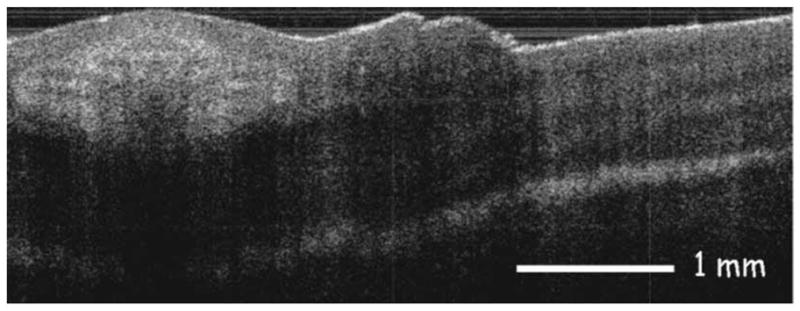
SSOCT image of human finger.
In summary, a PM-buffered FDML swept source was developed to double the scanning rate of the source without sacrificing the output power by combining two orthogonally polarized outputs with a PBC. The swept source is capable of an average power of 12 mW and an edge-to-edge tuning range of 152 nm at a 102 kHz sweeping rate. The axial resolution of the SSOCT system was measured to be 9.4 μm in air. The SSOCT system is capable of maximum sensitivity of 107.5 dB and an imaging range of 2.25 mm.
Acknowledgments
This work was supported by the National Institutes of Health (EB-00293, EB-10090, K25HL-102055, HL-103764, HL-105215, RR-01192), the Tobacco-Related Disease Research Program (19KT-0034), the Air Force Office of Scientific Research (FA9550-04-0101), and the Beckman Laser Institute Endowment.
References
- 1.Huang D, Swanson EA, Lin CP, Schuman JS, Stinson WG, Chang W, Hee MR, Flotte T, Gregory K, Puliafito CA, Fujimoto JG. Science. 1991;254:1178. doi: 10.1126/science.1957169. [DOI] [PMC free article] [PubMed] [Google Scholar]
- 2.Huber R, Wojtkowski M, Taira K, Fujimoto J, Hsu K. Opt Express. 2005;13:3513. doi: 10.1364/opex.13.003513. [DOI] [PubMed] [Google Scholar]
- 3.Yun SH, Tearney GJ, de Boer JF, Iftimia N, Bouma BE. Opt Express. 2003;11:2953. doi: 10.1364/oe.11.002953. [DOI] [PMC free article] [PubMed] [Google Scholar]
- 4.Zhang J, Nelson JS, Chen Z. Opt Lett. 2005;30:147. doi: 10.1364/ol.30.000147. [DOI] [PubMed] [Google Scholar]
- 5.Wojtkowski M, Srinivasan V, Ko T, Fujimoto JG, Kowalczyk A, Duker J. Opt Express. 2004;12:2404. doi: 10.1364/opex.12.002404. [DOI] [PubMed] [Google Scholar]
- 6.Cense B, Nassif N, Chen T, Pierce M, Yun SH, Park B, Bouma B, Tearney G, de Boer JF. Opt Express. 2004;12:2435. doi: 10.1364/opex.12.000367. [DOI] [PubMed] [Google Scholar]
- 7.Leitgeb R, Drexler W, Unterhuber A, Hermann B, Bajraszewski T, Le T, Stingl A, Fercher A. Opt Express. 2004;12:2156. doi: 10.1364/opex.12.002156. [DOI] [PubMed] [Google Scholar]
- 8.Huber R, Wojtkowski M, Fujimoto JG. Opt Express. 2006;14:3225. doi: 10.1364/oe.14.003225. [DOI] [PubMed] [Google Scholar]
- 9.Jeon MY, Zhang J, Wang Q, Chen Z. Opt Express. 2008;16:2547. doi: 10.1364/oe.16.002547. [DOI] [PMC free article] [PubMed] [Google Scholar]
- 10.Huber R, Adler DC, Fujimoto JG. Opt Lett. 2006;31:2975. doi: 10.1364/ol.31.002975. [DOI] [PubMed] [Google Scholar]
- 11.Adler DC, Chen Y, Huber R, Schmitt J, Connolly J, Fujimoto JG. Nat Photon. 2007;1:709. [Google Scholar]
- 12.Klein T, Wieser W, Eigenwillig CM, Biedermann BR, Huber R. Opt Express. 2011;19:3044. doi: 10.1364/OE.19.003044. [DOI] [PubMed] [Google Scholar]
- 13.Jirauschek C, Biedermann B, Huber R. Opt Express. 2009;17:24013. doi: 10.1364/OE.17.024013. [DOI] [PubMed] [Google Scholar]
- 14.Al-Qaisi MK, Akkin T. Opt Express. 2010;18:3392. doi: 10.1364/OE.18.003392. [DOI] [PubMed] [Google Scholar]
- 15.Liu G, Zhang J, Yu L, Xie T, Chen Z. Appl Opt. 2009;48:6365. doi: 10.1364/AO.48.006365. [DOI] [PMC free article] [PubMed] [Google Scholar]



